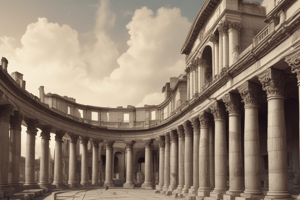Podcast
Questions and Answers
The Roman ______ system connected public baths, latrines, and streets.
The Roman ______ system connected public baths, latrines, and streets.
sewage
The two main streets in Roman cities were called ______ and decumanus.
The two main streets in Roman cities were called ______ and decumanus.
cardo
Roman ______ were advanced for their time, utilizing various surgical tools.
Roman ______ were advanced for their time, utilizing various surgical tools.
surgery
The ancient Romans built over 55,000 miles of paved ______ across their empire.
The ancient Romans built over 55,000 miles of paved ______ across their empire.
The Roman ______ was known for its durability and was used in major constructions.
The Roman ______ was known for its durability and was used in major constructions.
The ______ Calendar established a twelve-month system based on a solar year.
The ______ Calendar established a twelve-month system based on a solar year.
The ______ allowed the Romans to transport water using gravity.
The ______ allowed the Romans to transport water using gravity.
Roman ______ were used for complex calculations and communication.
Roman ______ were used for complex calculations and communication.
The ______ Diurna provided news in ancient Rome from 59 BC to 222 AD.
The ______ Diurna provided news in ancient Rome from 59 BC to 222 AD.
The ______ was used extensively by the Romans in the construction of bridges and aqueducts.
The ______ was used extensively by the Romans in the construction of bridges and aqueducts.
Flashcards are hidden until you start studying
Study Notes
Ancient Roman Inventions
- Ancient Rome was known for its innovations, taking existing technology and advancing it.
- The arch, while predating Roman civilization, was used extensively by the Romans, particularly for bridges, aqueducts, and the Colosseum.
- Romans were not the first to use grid-based city planning, but they used the concept on a massive scale, creating standardized cities throughout their empire. The two main streets were called "cardo" and "decumanus".
- The Roman sewage system was a marvel of engineering, connecting public baths, latrines, and streets with an extensive network of sewers.
- Roman roads and highways were essential for administering the empire, with over 55,000 miles of paved highways built across the Mediterranean Basin and Europe.
- Aqueducts, using gravity to transport water from rivers, springs, and reservoirs, allowed Romans to supply their cities with water for baths, fountains, and toilets.
- Roman numerals were essential for complex calculations and communication, replacing earlier counting systems.
- Roman surgery was advanced for its time, with bronze scalpels, bone drills, forceps, vagnial speculums, and the use of hot water for disinfection.
- The Julian Calendar, named after Julius Caesar, established twelve months and a solar year-based system. It was superseded by the Gregorian Calendar.
- The ACTA Diurna, published daily in Roman Forum between 59 BC and 222 AD, provided news of politics, trials, military campaigns, executions, scandals, and more.
- Roman concrete, using volcanic rock called tuff, was remarkably durable and environmentally friendly, allowing for the construction of lasting structures like the Pantheon and Colosseum.
Roman Innovations
- Romans widely adopted and advanced the use of the arch, notably in bridges, aqueducts, and the Colosseum.
- Romans established standardized cities across their empire, using a grid-based city planning system with two main streets: "cardo" and "decumanus".
- Roman sewage systems featured a complex network of sewers connecting public baths, latrines, and streets.
- Romans constructed over 55,000 miles of paved highways across the Mediterranean Basin and Europe, enabling efficient administration of the empire.
- Roman aqueducts utilized gravity to carry water from rivers, springs, and reservoirs, supplying Roman cities with water for baths, fountains, and toilets.
- Roman numerals were crucial for calculations and communication, replacing earlier counting systems.
- Roman surgeons employed bronze scalpels, bone drills, forceps, vaginal speculums, and hot water for disinfection, showcasing advancements in surgery.
- The Julian Calendar, named after Julius Caesar, established a twelve-month system based on a solar year, later replaced by the Gregorian Calendar.
- The ACTA Diurna, a daily publication in the Roman Forum (59 BC-222 AD), provided news on politics, trials, military campaigns, executions, scandals, and more.
- Roman concrete, incorporating volcanic rock (tuff), was remarkably durable and environmentally friendly, enabling the construction of lasting structures like the Pantheon and Colosseum.
Studying That Suits You
Use AI to generate personalized quizzes and flashcards to suit your learning preferences.




